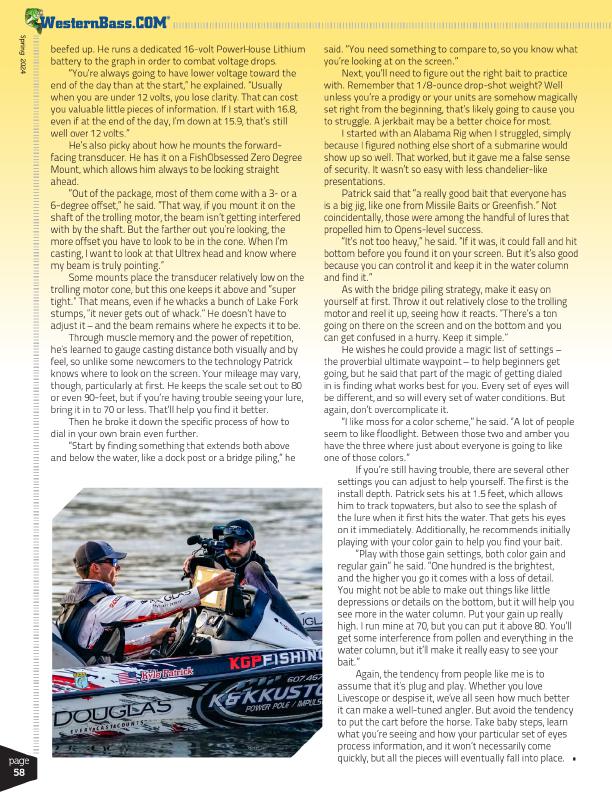
®
Spring 2024
page 58
beefed up. He runs a dedicated 16-volt PowerHouse Lithium battery to the graph in order to combat voltage drops.
“You’re always going to have lower voltage toward the end of the day than at the start,” he explained. “Usually when you are under 12 volts, you lose clarity. That can cost you valuable little pieces of information. If I start with 16.8, even if at the end of the day, I’m down at 15.9, that’s still well over 12 volts.”
He’s also picky about how he mounts the forward- facing transducer. He has it on a FishObsessed Zero Degree Mount, which allows him always to be looking straight ahead.
“Out of the package, most of them come with a 3- or a 6-degree offset,” he said. “That way, if you mount it on the shaft of the trolling motor, the beam isn’t getting interfered with by the shaft. But the farther out you’re looking, the more offset you have to look to be in the cone. When I’m casting, I want to look at that Ultrex head and know where my beam is truly pointing.”
Some mounts place the transducer relatively low on the trolling motor cone, but this one keeps it above and “super tight.” That means, even if he whacks a bunch of Lake Fork stumps, “it never gets out of whack.” He doesn’t have to adjust it – and the beam remains where he expects it to be.
Through muscle memory and the power of repetition, he’s learned to gauge casting distance both visually and by feel, so unlike some newcomers to the technology Patrick knows where to look on the screen. Your mileage may vary, though, particularly at first. He keeps the scale set out to 80 or even 90-feet, but if you’re having trouble seeing your lure, bring it in to 70 or less. That’ll help you find it better.
Then he broke it down the specific process of how to dial in your own brain even further.
“Start by finding something that extends both above and below the water, like a dock post or a bridge piling,” he
said. “You need something to compare to, so you know what you’re looking at on the screen.”
Next, you’ll need to figure out the right bait to practice with. Remember that 1/8-ounce drop-shot weight? Well unless you’re a prodigy or your units are somehow magically set right from the beginning, that’s likely going to cause you to struggle. A jerkbait may be a better choice for most.
I started with an Alabama Rig when I struggled, simply because I figured nothing else short of a submarine would show up so well. That worked, but it gave me a false sense of security. It wasn’t so easy with less chandelier-like presentations.
Patrick said that “a really good bait that everyone has is a big jig, like one from Missile Baits or Greenfish.” Not coincidentally, those were among the handful of lures that propelled him to Opens-level success.
“It’s not too heavy,” he said. “If it was, it could fall and hit bottom before you found it on your screen. But it’s also good because you can control it and keep it in the water column and find it.”
As with the bridge piling strategy, make it easy on yourself at first. Throw it out relatively close to the trolling motor and reel it up, seeing how it reacts. “There’s a ton going on there on the screen and on the bottom and you can get confused in a hurry. Keep it simple.”
He wishes he could provide a magic list of settings – the proverbial ultimate waypoint – to help beginners get going, but he said that part of the magic of getting dialed in is finding what works best for you. Every set of eyes will be different, and so will every set of water conditions. But again, don’t overcomplicate it.
“I like moss for a color scheme,” he said. “A lot of people seem to like floodlight. Between those two and amber you have the three where just about everyone is going to like one of those colors.”
If you’re still having trouble, there are several other
settings you can adjust to help yourself. The first is the
install depth. Patrick sets his at 1.5 feet, which allows
him to track topwaters, but also to see the splash of
the lure when it first hits the water. That gets his eyes
on it immediately. Additionally, he recommends initially
playing with your color gain to help you find your bait.
“Play with those gain settings, both color gain and
regular gain” he said. “One hundred is the brightest,
and the higher you go it comes with a loss of detail.
You might not be able to make out things like little
depressions or details on the bottom, but it will help you
see more in the water column. Put your gain up really
high. I run mine at 70, but you can put it above 80. You’ll
get some interference from pollen and everything in the
water column, but it’ll make it really easy to see your
bait.”
Again, the tendency from people like me is to
assume that it’s plug and play. Whether you love
Livescope or despise it, we’ve all seen how much better
it can make a well-tuned angler. But avoid the tendency
to put the cart before the horse. Take baby steps, learn
what you’re seeing and how your particular set of eyes
process information, and it won’t necessarily come
quickly, but all the pieces will eventually fall into place. •